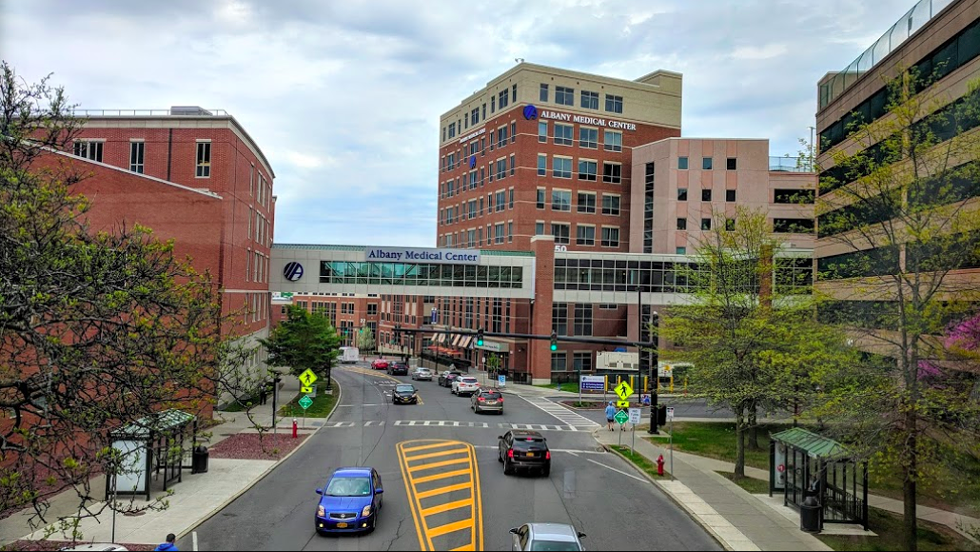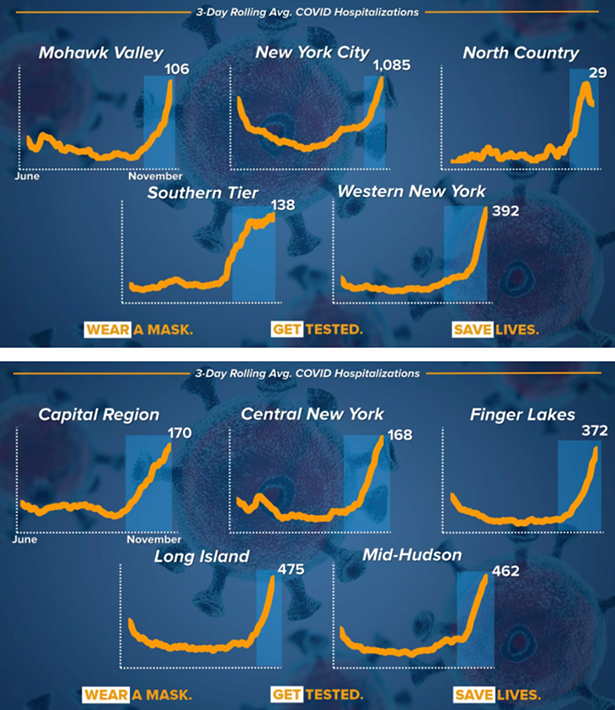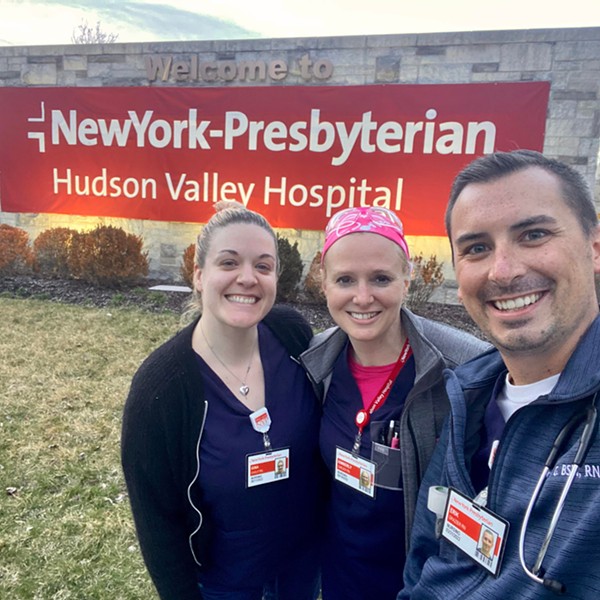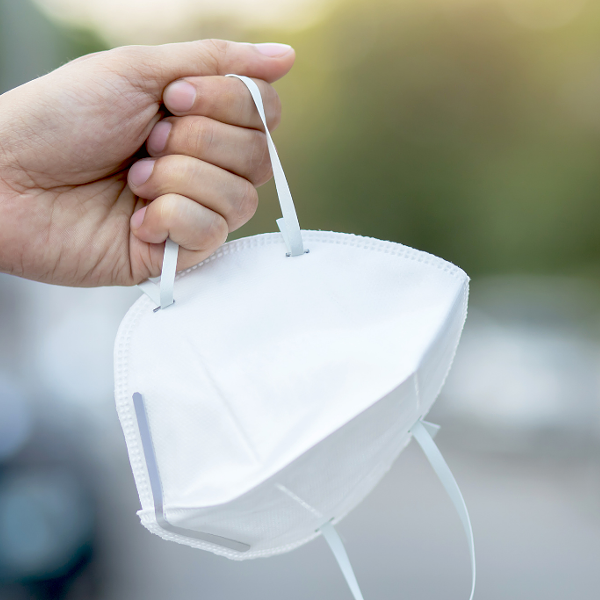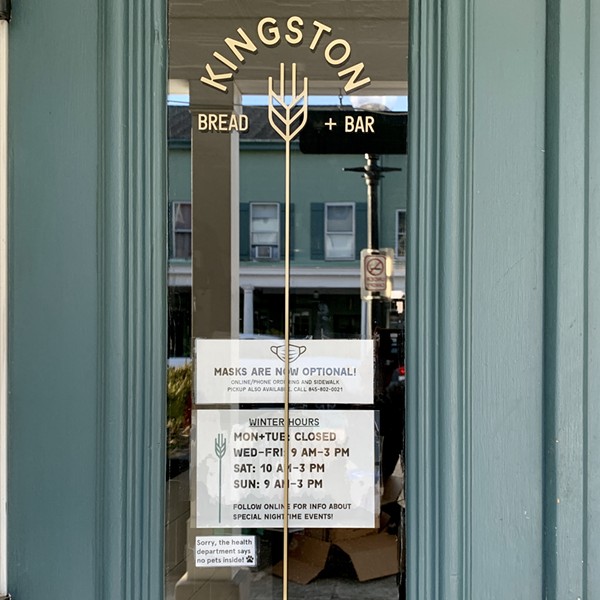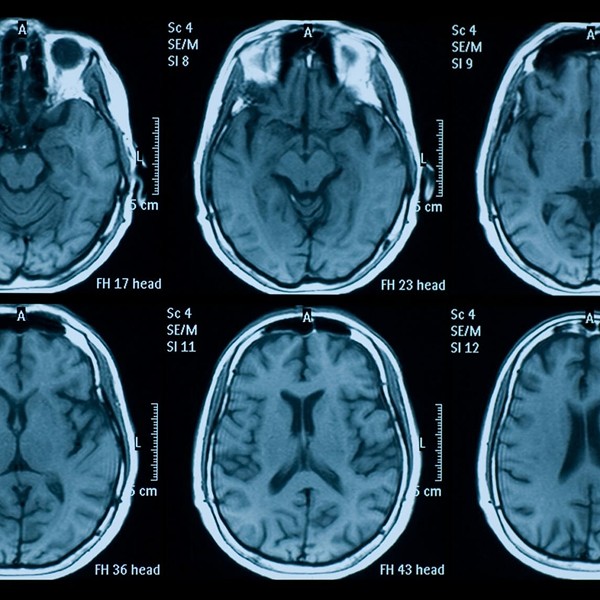This is a roundup of coronavirus news and announcements from New York State and Hudson Valley and Catskills counties for Saturday, November 28 through Monday, November 30. Published in collaboration with The Other Hudson Valley.
NEW YORK STATE
6,819 new cases yesterday
148,974 tests yesterday
Positive test rate: 4.58%
57 deaths yesterday
3,532 hospitalizations
681 ICU admissions
New York State coronavirus page
New York State official pressroom
Hotline: (888) 364-3065
New York State’s hospitals are in trouble again. In a televised Monday briefing, Governor Andrew Cuomo said that the state Department of Health is deploying emergency measures to keep hospitals from becoming overwhelmed by the fall surge of COVID-19 infection. “In the new battlefield, hospital capacity is the top concern, period,” he said.
Monday’s briefing also brought the state’s “winter plan” for battling the pandemic into sharper focus, although many details have yet to be revealed. New York’s strategy is shifting to respond to what Cuomo is calling a “new phase” of the pandemic, and central to the state response is the goal of keeping hospitals from being swamped with COVID-19 patients. Among the tools Cuomo said he might deploy, if hospitals become overloaded: A return to “NY On Pause” rollbacks on businesses and gatherings that would go beyond what has already been imposed in orange and red zones. “We’re going to add on top of yellow, orange, red, an emergency stop provision. Where we hit a real hospitalization crisis, we could potentially do a New York Pause,” he said.
New York State is once again preparing to deploy a “surge and flex” plan for distributing patients evenly throughout the state’s hospital systems, Cuomo said on Monday, using a phrase not heard in state briefings since the spring. Hospitals across the state have again been tasked with adding 50 percent capacity, a measure taken in late March when cases were spiking in the state. The state is also laying plans for field hospitals statewide, and one has already been established in Staten Island. Though the ramping up of hospital capacity efforts in New York carries some heavy spring surge deja vu, there are a few key differences: In some ways, we are better off now than in March, and in other ways, we face more of a challenge. Advances in treatment are yielding better survival rates for hospitalized patients, and hospitals have had time to shore up on PPE. But healthcare workers are stretched thin after almost nine months in the COVID-19 trenches, and with cases surging statewide and the rest of the nation mostly worse off than New York, there are few reserves of workers to draw on for help.
One resource the state is seeking to tap: Retired healthcare workers. State officials have tasked hospitals with identifying retired former workers who might be called upon for reinforcements. “We’re already experiencing staff shortages. Staff just gets exhausted after a while. They’ve had a horrendous year,” Cuomo said. With vaccination of frontline healthcare workers potentially mere weeks away, the prospect of bringing an older retired workforce back into hospitals to help lighten the load may not sound so grim soon.
The state’s microcluster strategy, already confusing and opaque, is about to become more so. Hospitalization data will soon be incorporated into the method for determining whether an area will be declared a microcluster “focus zone,” Cuomo said. “We’re going to shift the focus to the number of hospitalizations and hospital capacity. We’re going to add to our zone designations—the yellow, orange, red—the hospitalization rate,” he said. Details on how those calculations will work have not yet been released. For some communities, especially in rural areas, hospitalization rates are made more complicated by the fact that most COVID-19 patients are going far from their local areas, and in some cases out of county, for medical care.
Hospitalization rates are on a steep climb throughout the state, and in several regions, including hard-hit Western New York, hospitalizations are now far beyond their levels during the state’s spring peak. Hospitals in Erie County, which Cuomo said Monday is the site of “the most critical hospital situation in the state,” will be canceling all elective surgeries as of Friday, in another move reminiscent of the grim spring months. It is likely that hospitals in other regions will follow suit as case counts continue to climb, forcing many non-COVID patients to forego important medical care until the situation improves.
As of Monday evening, nurses at Albany Med were planning to follow through with a 24-hour strike beginning Tuesday at 7am. The nurses, who are represented by the New York State Nurses Association, told the Albany Times Union that they are resorting to a strike over longstanding concerns over employee and patient safety, including the lack of PPE, which have led to a stalemate in contract negotiations. On Monday, NYSNA filed a federal complaint with the Occupational Safety and Health Administration, arguing among other things that the hospital’s safety protocols are putting nurses at heightened risk of exposure. Of particular concern is the reuse of N95 masks, which nurses say are being reused up to 20 times, with different patients. Albany Med has defended reusing masks as part of a strategy to ensure an adequate supply going forward. NYSNA also circulated a four-page report it commissioned from Olmsted Environmental Services—a Putnam County-based firm that consults on industrial hygiene—to review nurses’ complaints regarding infection control practices. “It is my professional opinion that the nurses at Albany Medical Center have been placed at unreasonable risk of exposure to COVID-19 while performing their jobs,” the report states.
In Sunday’s test-positivity data, even the statewide rate with focus zones excluded was a hair above 4 percent. Data is still probably a little bouncy because of the recent holiday, and the past few days have seen a dip in testing numbers, so it’s hard to say how complete a picture is painted by the most recent data. But the statewide positivity rate hasn’t been this high since May—and because New York is doing much more testing now than in the spring, the current positivity rate represents about four or five times as many actual cases as the same rate would have in mid-May.
Another prong of New York State’s winter plan: Increased testing. In Monday’s briefing, Cuomo said that the state would work with local governments to ramp up testing in a variety of situations: workplaces, nursing homes, police and fire departments, and schools.
New York’s strategy for schools in microcluster “focus zones” is also changing. Current guidance requires schools in orange and red zones to close. The state is seeking to keep K-8 classrooms open, even in hard-hit focus zones, and will shift to a strategy of requiring schools in all zones to meet testing targets, possibly with help from the pooled testing resources of the SUNY system. It is likely that if the state does not step up to help school districts meet testing requirements, many will be unable to stay open; already, in yellow zones where schools are not required to shut down, several schools have opted to close rather than take on the expense and logistics of mass testing.
Small gatherings are driving the bulk of the current case spike, Cuomo said, although it was not clear what data he was relying on. “The small gathering spread is now the number one spreader. That is 65 percent of all cases,” the governor said. New York State does not release data on the settings in which transmission has been found or the percent of cases that can be traced to a known source; health officials in some New York State counties have said that most of their cases cannot be traced, and many people are not cooperating with contact tracers.
Several county executives, including Westchester County’s George Latimer, joined Governor Cuomo on a public Zoom call at the end of the briefing to talk about planning for the winter. Also on the line: New York City Mayor Bill de Blasio, who traded compliments with the governor, to the astonishment of observers of the long-running political one-upmanship between the two. Local county and city governments will soon have a critical role to play in the distribution of vaccines, which appears likely to begin before the end of the year for the highest-priority groups.
About those high priority groups: STAT News reports, to our chagrin, that there is some federal infighting over who should come first. Most experts, including CDC brass, believe healthcare workers should be first in line, but some Trump administration officials want nursing home residents to be included in the first round. The conflict is injecting uncertainty into planning at the state level, and prompting an unusual emergency decision by a committee tasked with making official recommendations. Vulnerable nursing home residents are likely to be high priority for vaccination regardless of whether they end up included in the first round, but with limited data on vaccine effectiveness in elderly populations and greater logistical challenges involved with vaccinating them, many experts feel that the first round of vaccination should focus on healthcare workers.
Moderna said on Monday that it would apply for an emergency use authorization from the FDA, the second biotech company to seek approval, after Pfizer did so last week. Moderna shared the full analysis of its coronavirus vaccine trials, which showed 94 percent efficacy.
The Supreme Court struck a blow at New York State’s COVID-19 regulations in a Wednesday ruling that overturned Governor Cuomo’s tough capacity restrictions on religious gatherings in red and orange zones. The lawsuit was brought by the Catholic diocese of Brooklyn and a coalition of Orthodox Jewish leaders.
A bill that would give New York State restaurants some relief is gaining some bipartisan traction in the state legislature. It’s pretty small potatoes, though: The bill would give restaurants a one-week exemption from collecting sales tax. The Times Union’s Steve Barnes doesn’t think much of it either. “Maybe this is just me, but I don’t foresee a business-saving horde suddenly ordering from restaurants repeatedly in the same week because two entrees from Johnny’s in Schenectady would be $50 instead of $54,” he writes. A federal bill that has already cleared the House would do more, if it passed—but that’s a big if.
Four people currently serving on grand juries in New York State have tested positive for COVID-19 in the past week, the New York Law Journal reports. The state has suspended new grand jury proceedings, but so far, pending grand jury procedures are still being held.
The pandemic is taking a toll on…scented candles. An enterprising data wrangler dug into Amazon reviews of candles recently, and found that reviews complaining about a lack of scent have tracked pretty well with national COVID-19 surges. If your new cinnamon-and-fir candle doesn’t smell like anything, you might consider getting a COVID test.
One thing COVID-19 can’t keep down: The endless series of New York Times lifestyle features about the problems of well-heeled urban transplants in upstate New York. The most recent installment, “Welcome To Homeownership,” features a few former city dwellers who found out the hard way that boilers don’t fix themselves, and a smattering of both bad and good advice. Nextdoor as a good way to connect with your neighbors? Uh, maybe in Jersey. But do mind the Phoenicia realtor’s advice about bears, folks.
Microcluster Focus Zone Update
New York State’s current strategy for curbing infection assigns neighborhoods with outbreaks to “microcluster focus zones” that are coded red, orange, or yellow depending on severity. The NY Forward website has a guide to the restrictions on business, schools, worship, and gatherings, plus high-resolution maps of focus zones in the microclusters.
No changes have been made to New York State’s focus zones since our Wednesday roundup. The state currently has 26 microcluster focus zones, located in Erie, Niagara, Monroe, Onondaga, Rockland, Chemung, Tioga, Orange, Nassau, Suffolk, and Westchester counties, as well as in Queens, the Bronx, Brooklyn, Manhattan, and Staten Island. The positivity rate across New York State’s focus zones in Sunday’s data was 6.22 percent. The positivity rate statewide with the focus zones excluded was 4.02 percent. Detailed information on recent positivity rates in each of the state’s focus zones is available in a press release on the state website.
LOWER HUDSON VALLEY
County coronavirus pages: Rockland, Westchester, Putnam
University coronavirus pages: Sarah Lawrence, Iona, SUNY Purchase, Manhattanville, Westchester Community College, Rockland Community College, Dominican, Mercy
The Rockland County Department of Health began a concentrated testing period of schools in the county’s yellow zones on Monday. Schools within the microcluster are required to test at least 20 percent of students, faculty, and staff by December 9. If the positivity rate is higher than the yellow zone average, the 20 percent testing protocol will be continued for two additional weeks. If the positivity rate is lower than the microcluster average, in-person instruction can continue sans testing. Good Samaritan Hospital, in Suffern, is providing staff to perform the tests at a range of sites this week between 11am and 2pm. On Facebook, some teachers complained that the East Ramapo school district is not permitting teachers to leave campus to get tested during the school day; the county says that the details of the plan were coordinated “with the input of local teachers.” More details are available at the county’s website.
Total hospitalizations in Rockland County actually declined slightly over the weekend, to 60. There are currently 1,488 cases of COVID-19 in the county. On Sunday, 4.7 percent of those tested were positive for the virus—130 new cases. The county reported four deaths Monday.
Westchester County hospitalizations have doubled in two weeks to their highest level since May 31, and the active case count has soared past 6,000, County Executive George Latimer said in a Monday coronavirus briefing. Latimer said that Westchester hospitals, which have about 3,000 beds overall, are not near capacity, but that the county might need to accept sick patients from elsewhere. The county reported 583 new cases on Sunday, with a test positivity rate of 5.8 percent. Westchester surpassed 50,000 total cases of COVID-19 over the weekend.
Putnam County’s caseload has continued to surge, as well, though county officials haven’t provided a comprehensive update since November 20. Over that time, the county has had one of the highest positive-test rates in the state. On Sunday, 55 more people tested positive for COVID-19, 6.7 percent of total persons tested in the county.
Westchester County is offering free flu shots to residents seven and older this week at the Westchester County Center in White Plains. Registration is required. Appointments are available on Thursday between 4pm and 8pm; Saturday between 9am and 3pm; and Sunday from 9am to 12pm.
On Monday, Westchester County’s Office of Economic Development launched Westchester RISES, a free program to support existing businesses “looking to pivot or rebuild in response to the pandemic, or build resilience to prepare for whatever shock might be next.” The program consists of virtual workshops and roundtables over the next six months to help businesses prepare for future challenges. It is a partnership with Accel7, a startup accelerator in New Rochelle.
MID-HUDSON VALLEY
County coronavirus pages: Orange, Dutchess, Ulster, Columbia
University coronavirus page: Bard, Vassar, Marist, SUNY New Paltz, SUNY Ulster, Columbia-Greene Community College, SUNY Orange
Dutchess County’s health department is losing 15 percent of its workforce after county employees were offered buyouts as a cost-saving measure in the midst of economic turmoil wrought by the pandemic. Democratic legislators are urging more funding for the department, according to a press release, pointing to county Health Commissioner Dr. Anil Vaidian’s declaration that his department didn’t have the staff to test the number of students necessary to keep schools open if the area was declared a yellow zone.
American Airlines will not return to Stewart Airport, according to the Times-Herald Record. Service to the airport was suspended after ridership plunged during the pandemic, and an airlines spokesman said continued economic woes in the industry was forcing them to indefinitely suspend service at the Newburgh airport. JetBlue and Delta Airlines indefinitely suspended service at the airport in October. A single airline now remains at the airport.
Poughkeepsie Mayor Rob Rolison tested positive for COVID-19 late last week after becoming ill on Monday. The Poughkeepsie Journal reports he experienced a fever, aches, and exhaustion, but never became seriously ill and hopes to be back at his office next week. Saugerties Supervisor Fred Costello announced on Facebook on Thursday that he had tested positive for the virus, though he was only experiencing a slight fever. His family business, Sue’s Restaurant, has closed as a precaution. Both officials said they started quarantining as soon as they felt ill.
A walkup testing clinic will be held in Hudson at the former John L. Edwards school on Tuesday from 9am to 11am. Pre-registration is not required. A mobile testing clinic will be held in New Lebanon at Shatford Park from 10am to noon on December 8. Registration is required on the county Department of Health website.
A resident of Ghent Nursing and Rehabilitation has died of COVID-19, the Columbia County Department of Health announced Monday, the 46th death in the county. The number of active cases continued to fall, reaching 54 on Monday. Cases peaked at 100 on November 7.
Ulster County reported two new deaths from COVID-19 on Monday. There are currently 928 known cases in the county, the most since April 28.
Orange County Executive Steve Neuhaus gave an age breakdown of residents who have died of COVID-19 during a briefing Monday. Of the 526 victims, 285 were above the age of 74; 115 were between the ages of 65 and 74; 91 were between the ages of 45 and 64, and 22 were between the ages of 18 and 44.
CATSKILLS
County coronavirus pages: Sullivan, Delaware, Greene, Schoharie
University coronavirus pages: SUNY Cobleskill, SUNY Delhi, SUNY Sullivan
One Greene Correctional Facility inmate tested positive in data released Monday by Greene County health officials, the first case at the state prison since mid-November. An October outbreak of more than 100 cases at the prison spilled out into the community, affecting a local elementary school and a Columbia County nursing home, and a second smaller outbreak at the prison broke out in early November. Greene County currently has 62 active cases, including the one at the prison, and two county residents are hospitalized.
On-the-ground local reporting and analysis has never been more important, and that’s what The River aims to provide. But we need your help to continue the work we’re doing. Will you support our journalism today?
OF INTEREST?
The River has a guide on where, how, and when to get tested for the coronavirus in the Hudson Valley and Catskills. To read more of our coronavirus coverage, visit our coronavirus page.
The River is collaborating with WGXC to announce these updates over the air. To listen, tune in to 90.7 FM at midnight, 5am, 7am, or 9am, or visit the audio archive online.
La Voz, una revista de cultura y noticias del Valle de Hudson en español, está traduciendo estos resúmenes y co-publicandolos en su página web. Leyendo aqui. También puede escuchar actualizaciones diarias por audio en el show “La Voz con Mariel Fiori” en Radio Kingston.







